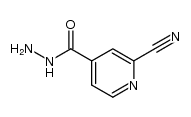577778-58-6
| Name | 4-(5-pyridin-4-yl-1H-1,2,4-triazol-3-yl)pyridine-2-carbonitrile |
|---|---|
| Synonyms |
4-[5-(pyridin-4-yl)-1H-1,2,4-triazol-3-yl]pyridine-2-carbonitrile
4-[5-(4-pyridinyl)-1H-1,2,4-triazol-3-yl]-2-Pyridinecarbonitrile Uriadec Topiroxostat 2-Pyridinecarbonitrile, 4-[5-(4-pyridinyl)-1H-1,2,4-triazol-3-yl]- 4-[3-(4-Pyridinyl)-1H-1,2,4-triazol-5-yl]-2-pyridinecarbonitrile Topiloric Topiroxostat [INN] Uriadec (TN) [14C]-Topiroxostat FYX 051 |
| Description | Topiroxostat(FYX-051) is a novel and potent xanthine oxidoreductase (XOR) inhibitor with IC50 value of 5.3 nM.IC50 value: 5.3 nM [1]Target: xanthine oxidoreductasein vitro: Steady-state kinetics study showed that FYX-051 initially behaved as a competitive-type inhibitor with a K(i) value of 5.7 × 10(-9) M, then after a few minutes it formed a tight complex with XOR via a Mo-oxygen-carbon atom covalent linkage, as reported previously [3].in vivo: FYX-051 exhibited a weak CYP3A4-inhibitory activity (18.6%); its Cmax and bioavailability were as high as 4.62 μg/mL (3 mg/kg) and 69.6%, respectively. Moreover, the t1/2 value of 39 was greater (19.7 h) than that of compound 2 (0.97 h) [1]. In the mechanistic study by 52-week oral treatment with topiroxostat at 3 mg/kg to F344 male rats, with and without citrate, simple and papillary transitional cell hyperplasias of the urinary bladder epithelium were observed in 5/17 in the topiroxostat-alone treatment group, along with xanthine-induced nephropathy, in contrast to neither xanthine crystals nor lesions in urinary organs by co-treatment group with citrate [2]. |
|---|---|
| Related Catalog | |
| References |
| Density | 1.5±0.1 g/cm3 |
|---|---|
| Boiling Point | 594.7±60.0 °C at 760 mmHg |
| Molecular Formula | C13H8N6 |
| Molecular Weight | 248.243 |
| Flash Point | 175.3±18.1 °C |
| Exact Mass | 248.081039 |
| PSA | 91.14000 |
| LogP | 1.35 |
| Vapour Pressure | 0.0±1.7 mmHg at 25°C |
| Index of Refraction | 1.697 |
|
~% 
577778-58-6 |
| Literature: EP1471065 A1, ; Page 8 ; |
| Precursor 2 | |
|---|---|
| DownStream 0 | |



